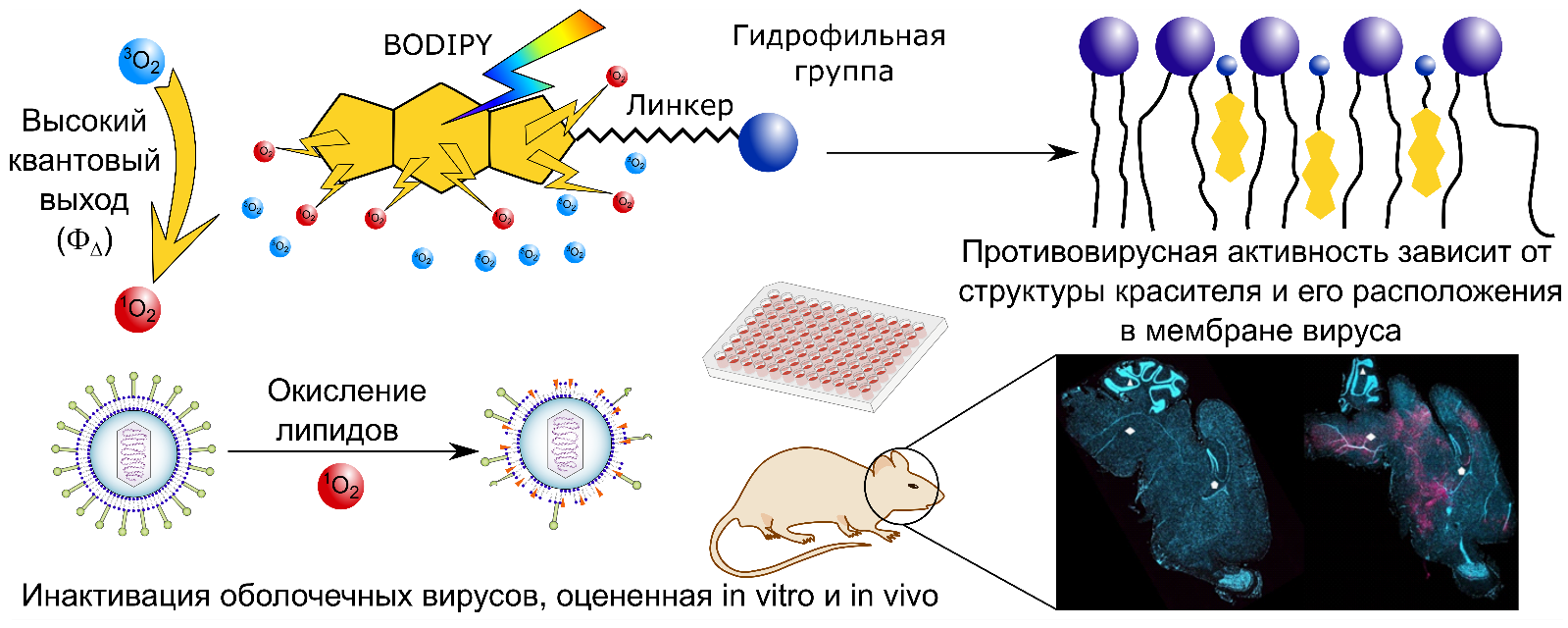- Статьи
- Science and technology
- A bezel-less perspective: new drugs will protect against coronavirus and encephalitis
A bezel-less perspective: new drugs will protect against coronavirus and encephalitis

Scientists synthesized new antiviral compounds capable of damaging the envelope of many viruses - for example, tick-borne encephalitis and coronavirus - and preventing them from fusing with the cell. Moreover, under the influence of green light, the effectiveness of the drugs increased by more than 60 times. The resulting drugs could potentially be used in the creation of vaccines. However, it is necessary to make sure of their safety, experts are sure.
Broad-spectrum antiviral agents
Scientists from the Institute of Bioorganic Chemistry named after Academicians M.M. Shemyakin and Y.A. Ovchinnikov (IBH) of the Russian Academy of Sciences with colleagues from other Russian and foreign scientific organizations have synthesized 35 compounds that destroy the membranes of various enveloped viruses and are potentially capable of preventing the development of many infections. Subsequently, on the basis of these substances it will be possible to create a drug or a series of drugs against a wide range of infections.
As a base, the authors used a derivative of cyclic fluorine- and boron-containing substance BODIPY, which is able to penetrate the membranes of enveloped viruses. The researchers then added iodine and bromine atoms to it, which enhance the production of reactive oxygen species that disrupt the integrity of viral particles.
- Synthesized by us compounds can potentially be used in medicine in the therapy of surface viral infections- told "Izvestia" senior researcher of the Institute of Biochemistry of the Russian Academy of Sciences Vera Alferova.
The researchers tested how the obtained substances affect coronavirus and tick-borne encephalitis virus. To do this, the authors used cell culture obtained from the kidney of a monkey, as well as human lung cancer cells. Such cell lines are often used when studying the life cycle of enveloped viruses that infect humans or closely related species.
First, the scientists showed that the synthesized drugs did not reduce cell viability. Then, for two days, the scientists grew cells infected with tick-borne encephalitis virus and coronavirus, in the nutrient medium to which they added the obtained compounds. The antiviral activity of the new molecules turned out to be comparable to the activity of drugs, including a coronavirus drug already approved for human treatment.
Envelope viruses, such as tick-borne encephalitis virus, influenza and coronavirus, are causative agents of dangerous infections in humans. Thus, the annual total mortality rate from tick-borne encephalitis in Russia is 2%. At the same time, many of the enveloped viruses, such as influenza, are constantly mutating, due to which drugs against them become ineffective.
Why irradiate viruses with green light
After that, the researchers established the mechanism of action of the synthesized compounds. It turned out that the drugs directly inhibit the activity of viral particles before they penetrate into the cells.
The scientists also found out how the antiviral activity of compounds changes after irradiating them with green light, in the absorption region of BODIPY dyes. To do this, the researchers mixed viral particles with the obtained substances and then irradiated them. The experiment showed that under the influence of green light was the release of reactive oxygen species, while the antiviral activity of some drugs increased more than 60 times.

In addition, the new compounds inhibited enveloped viruses from different groups: tick-borne encephalitis virus, coronavirus, herpes simplex and monkeypox viruses. Thus, the obtained substances can form the basis of prophylactic and therapeutic drugs that can fight a wide range of pathogens.
Moreover, the authors showed: if the tick-borne encephalitis virus was incubated with the proposed compounds for an hour and at the same time ten minutes irradiated the particles with green light, they could not cause infection in mice. Thus, the obtained compounds can potentially be used in the development of inactivated vaccines.
- Our future research will be centered on new BODIPY-based compounds that can absorb infrared radiation penetrating deeper into tissues. In addition, we plan to obtain substances with several mechanisms of action, including those that are effective without irradiation," said Vera Alferova.
Creation of antiviral drugs is a very promising direction, Albert Rizvanov, head of the center of excellence "Personalized Medicine" of Kazan (Volga Region) Federal University, corresponding member of the Academy of Sciences of the Republic of Tatarstan, told Izvestia. The pandemic has shown that virus envelope membranes can be considered one of the promising therapeutic targets, but we should remember that these envelopes are often very similar to the membranes of our own cells, and therefore it is extremely important to find a balance here.
In general, mankind is on the way to finding some form of drugs for viral diseases. The discovery of Russian scientists may become a breakthrough in the treatment of tick-borne encephalitis and coronavirus infection. From coronavirus today there are already imported drugs of high efficiency and domestic analogs, but tick-borne encephalitis remains a dangerous disease, so the search for an effective drug for it remains very important, said therapist of the clinic "Semeynaya" Alexander Lavrishchev.
- It is worth saying that such drugs can be taken only on the prescription of a doctor. Secondly, today on the medical market there are two types of drugs for viral infections: "helping from everything" and specific ones. The former drugs violate the laws of nature, and the latter are few in number. This is due to the fact that any effective drugs for viral infections fit specific viruses like a key to a lock," the expert said.
The results of the study, supported by a grant from the Russian Science Foundation (RNF), were published in the journal ACS Applied Materials & Interfaces.
Переведено сервисом «Яндекс Переводчик»


